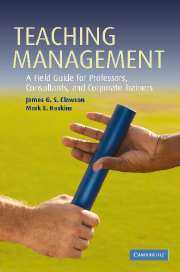Book contents
- Frontmatter
- Contents
- List of figures
- Sources to chapter quotations
- Why this book on teaching management?
- 1 Fundamental elements in teaching
- 2 Levels of learning: one, two, and three
- 3 Adult learning theory: it matters
- 4 Planning a course: trips and tips
- 5 Planning a class: no detail is too small
- 6 Lecturing: the possibilities and the perils
- 7 Managing discussions
- 8 Case method: fostering multidimensional learning
- 9 Role-playing
- 10 Case writing: crafting a vehicle of interest and impact
- 11 Case teaching notes: getting from here to there
- 12 Action learning
- 13 Experiential methods
- 14 Enhancing the conversation: audiovisual tools and techniques
- 15 Executive education: contributing to organizational competitive advantage
- 16 Using technology to teach management
- 17 Counseling students
- 18 Evaluating students: the twin tasks of certification and development
- 19 Teaching evaluations: feedback that can help and hurt
- 20 Research presentations
- 21 Managing a degree program: behind the ‘glory’
- 22 Managing a nondegree client program: an overview
- 23 Dealing with the press
- 24 Managing yourself and your time
- 25 Using teaching portfolios and course portfolios
- 26 Conclusion: is this on the exam?
- Index
18 - Evaluating students: the twin tasks of certification and development
Published online by Cambridge University Press: 25 February 2010
- Frontmatter
- Contents
- List of figures
- Sources to chapter quotations
- Why this book on teaching management?
- 1 Fundamental elements in teaching
- 2 Levels of learning: one, two, and three
- 3 Adult learning theory: it matters
- 4 Planning a course: trips and tips
- 5 Planning a class: no detail is too small
- 6 Lecturing: the possibilities and the perils
- 7 Managing discussions
- 8 Case method: fostering multidimensional learning
- 9 Role-playing
- 10 Case writing: crafting a vehicle of interest and impact
- 11 Case teaching notes: getting from here to there
- 12 Action learning
- 13 Experiential methods
- 14 Enhancing the conversation: audiovisual tools and techniques
- 15 Executive education: contributing to organizational competitive advantage
- 16 Using technology to teach management
- 17 Counseling students
- 18 Evaluating students: the twin tasks of certification and development
- 19 Teaching evaluations: feedback that can help and hurt
- 20 Research presentations
- 21 Managing a degree program: behind the ‘glory’
- 22 Managing a nondegree client program: an overview
- 23 Dealing with the press
- 24 Managing yourself and your time
- 25 Using teaching portfolios and course portfolios
- 26 Conclusion: is this on the exam?
- Index
Summary
In school you get the lesson first and then the test. In life you get the test and then the lesson.
– Tom Groneberg, The Secret Life of CowboysGrading students is an established part of university education. Few professors find this task a particularly pleasant one. Most bemoan the tedium and time required to read exams, correct papers, and to determine final grades, especially the lower ones. In some ways this is similar to the attitude regarding performance appraisals in business. Many managers shrink from giving performance appraisals as they do not have the right information to make an evaluation, and they do not feel comfortable judging another person's life. Yet, periodic assessments of performance are critically important. This chapter introduces some principles and techniques for evaluating students.
Why evaluate students?
The two primary reasons for evaluating students are (1) to provide feedback that contributes to their learning (i.e., the developmental objective) and (2) to render a judgment regarding their mastery of a body of knowledge (i.e., the certification objective). In the former, the evaluative signals we send to students (i.e., grades, comments, debriefs, etc.) can and should be given in such a way as to foster a student's “doublelooped learning” (Chris Argyris's term as used in Korth, 2000). That is, assessment feedback is a second-order input into the cues and content that students receive, process, assimilate, and adopt as part of their “sense making” (Weick, 1979) of the world within which they reside or strive to enter.
- Type
- Chapter
- Information
- Teaching ManagementA Field Guide for Professors, Consultants, and Corporate Trainers, pp. 323 - 350Publisher: Cambridge University PressPrint publication year: 2006



